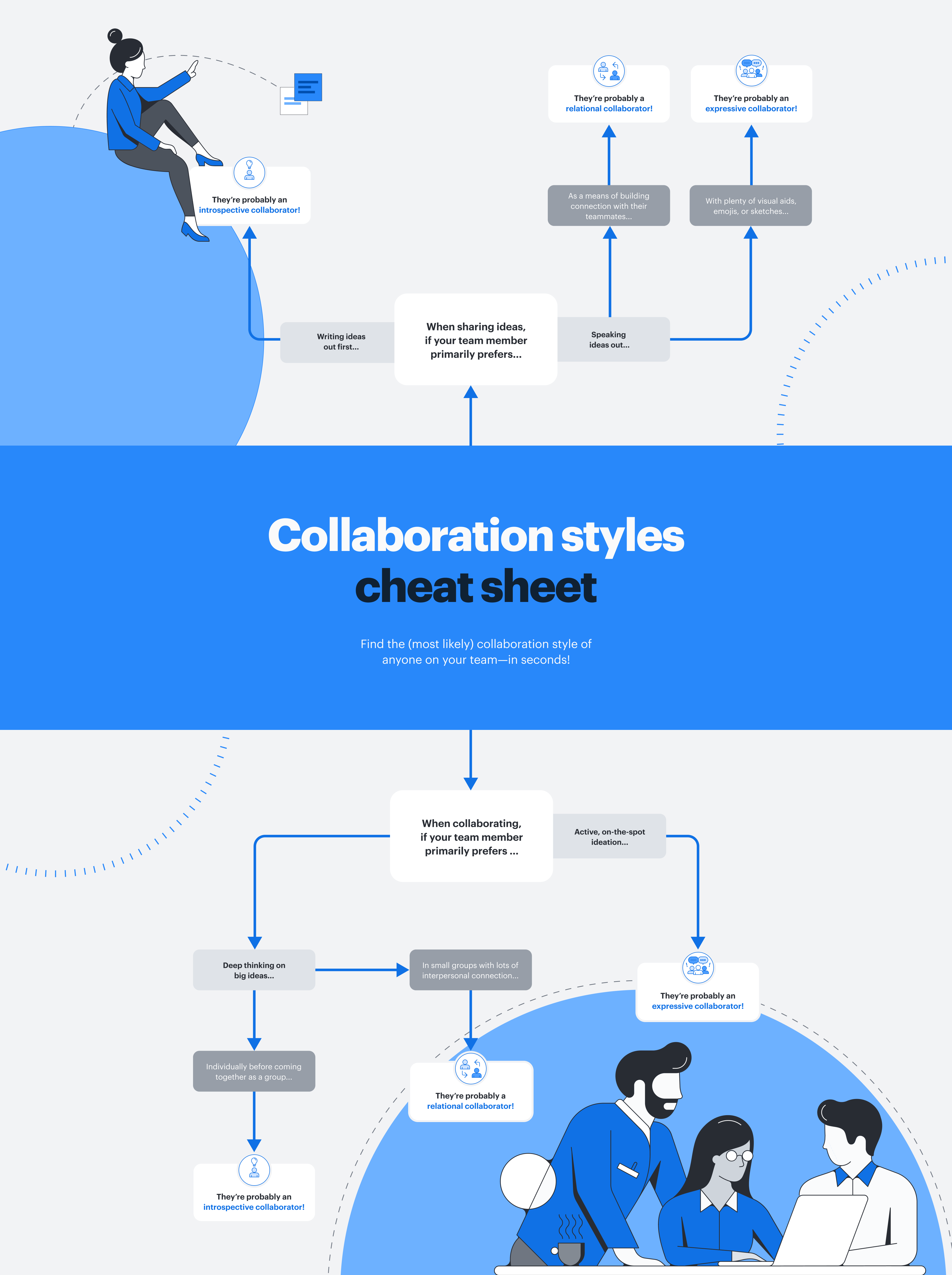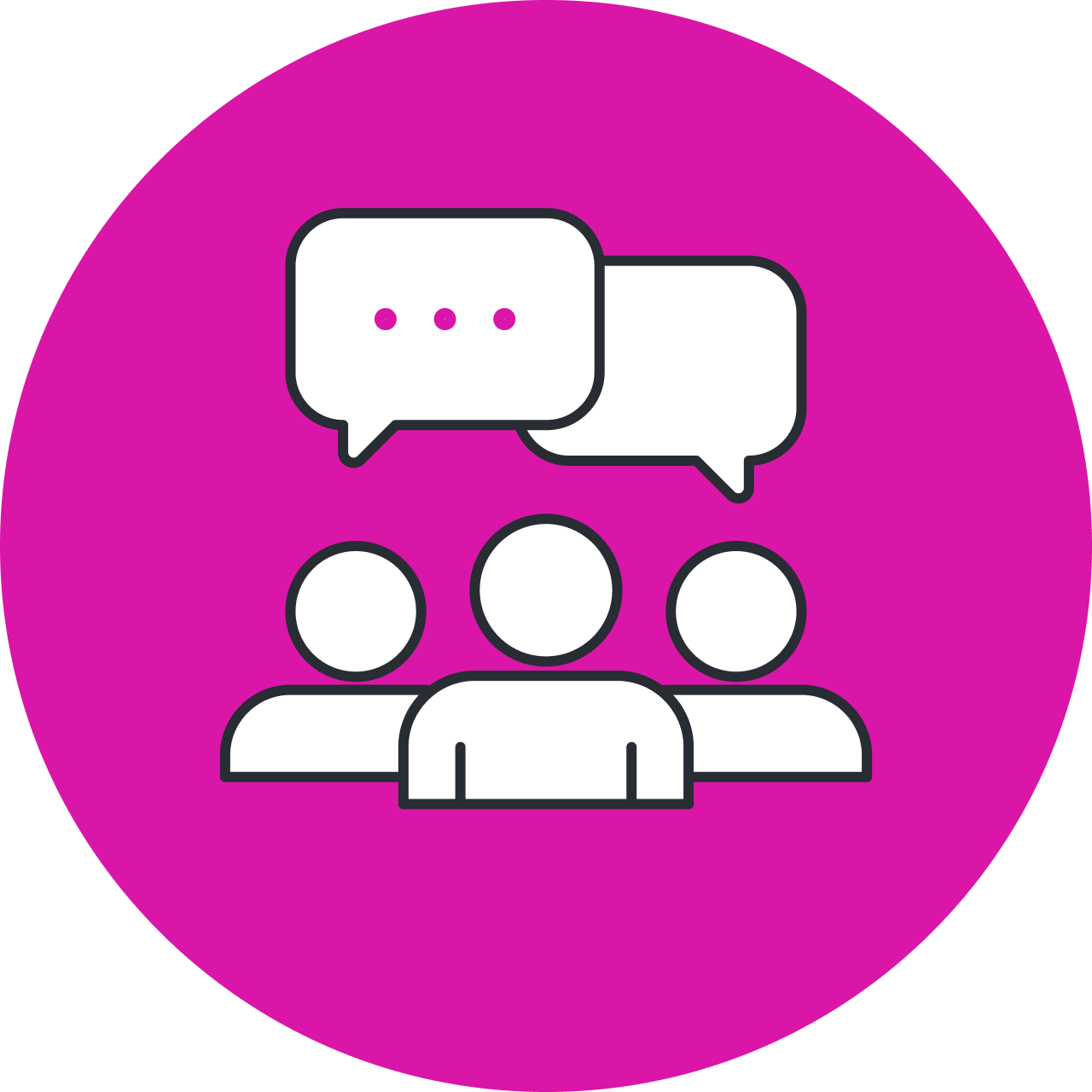
Want to improve your team’s performance? Learn their collaboration styles.
Reading time: about 10 min
Topics:
When we think about meetings, it’s not often the obviously pointless ones that are the most infuriating (these types of meetings are easy to phase into asynchronous touchpoints or just cancel altogether).
The truly maddening meetings are the ones that have so much potential to be better, but just aren’t—and they’d be the most valuable meetings on your calendar if only people would collaborate better.
You know the ones. They’re the meetings where:
- Everyone is talking a lot but no one seems to be hearing each other.
- The team continually circles around the problem you’re trying to solve, but never identifies the heart of the issue or the outcome you’re trying to accomplish.
- Certain voices routinely dominate the discussion as other voices get more and more comfortable fading into the background.
- No one is really communicating or sharing thoughts, and so the designated facilitator has to default to being the primary contributor.
- Teammates feel afraid or apprehensive to share truly innovative ideas out of fear of judgment or casual dismissal.
It’s not uncommon in these meetings to feel like everyone is speaking their own language.
And when most of your meetings are spent toiling in frustration that others don’t speak your same language—versus being able to dig into meaningful problem-solving, ideation, and creative thinking as a unified group—it’s no wonder productivity is down.
Collaboration is a human issue before it’s a process issue
When you observe stark collaboration differences among the people on your team, it might feel tempting as a leader to try and get your team standardized on collaborating in the way you want and the way you feel is most effective. It also might be tempting to simply introduce a new tool, use a new framework, or add a meeting to the calendar and hope that solves the problem.
But you can’t create better collaboration through sheer brute force, and attempting to might just make the matter worse.
Why? Because managers and their direct reports see collaboration issues very differently.
A recent report by Slack on workplace collaboration found that managers viewed how fast or slow their teammates worked as the top collaboration challenge. Non-manager employees, on the other hand, viewed misunderstandings and lack of clarity in communication as the top challenge.

It’s natural for leaders to have their eye more on the business bottom line as they attempt to tweak and optimize the pace at which their team works. But any attempt to fix collaboration without first understanding why certain teammates feel misunderstood will likely result in them feeling more misunderstood, not less.
And perhaps most important to remember: Since a team is just a group of people united around common goals, team issues are really just people issues. To fix collaboration at the team level, you first have to start with the individual.
So, what can leaders do to better accommodate individual collaboration preferences, improve team alignment, and ultimately increase productivity?
Understanding your team members’ unique collaboration styles
While each person is unique, Lucid has identified three common collaboration styles that many knowledge workers align themselves with: introspective, relational, and expressive.
We’ve written at length about how individuals can better understand their own collaboration style and those of their teammates in order to tap into their most productive, effective selves at work.
Leaders also have a responsibility to accommodate different styles and be rigorous in their design of meetings, team common spaces, collaborative sessions, working agreements, and more to make sure they are tailored to fit their team’s collaboration styles.
Here’s how to go about doing that:
1. Figure out how your team prefers to collaborate
The first step is easy: Simply learn what your team members’ styles are! You can do that in just a few minutes by taking Lucid’s collaboration styles quiz below:

Discover your team members’ collaboration styles with this short quiz.
Take it nowIn short, here are the preferences for each of the three styles:
- Expressive collaborators prefer visual, engaging activities and working in teams.
- Relational collaborators thrive on deep human connection.
- Introspective collaborators prefer individual ideation before group sharing.
It’s important to remember, however, that most people won’t fit 100% into just one of these categories; they might have limits to how much they align with a certain style or feel like they are a bit of both. This might look like someone on your team saying:
- “I’m an expressive collaborator 90% of the time, but I do need introspective working time each week to feel meaningfully connected to the work.”
- “I’m equal parts relational and introspective—I can get deep work done with other people so long as the group is small and has a lot of interpersonal trust.”
- “I’m a relational collaborator in my day-to-day work, but for one-off initiatives or cross-functional projects, I like to get more expressive.”
If this is your first time diving into your team’s collaboration styles, your team might need some real working time together to cement your learnings. Someone on your team might think they are a certain collaboration style in theory but find their preferences change as they actually start to work together with colleagues.
Encourage your team to explore the margins of their preferred style and communicate those unique preferences and differences with you and your team. Then record your styles in a team charter so everyone on the team has visibility.

2. Accommodating your team’s stated collaboration preferences in real-world scenarios
Once you understand the complete picture of how your team likes to work, you can utilize different frameworks or activities to accommodate these preferences. Because everyone on your team has their own style, it will require a unique mix of frameworks and collaboration strategies to find the one that works best for your team.
Here are some approaches and techniques you might consider trying:
- Brainwriting: Many teams never branch out from their standard method of brainstorming—throwing a bunch of ideas out at once, loosely taking notes, and hoping something sticks.
The brainwriting brainstorming technique accommodates introspective and expressive collaborators equally, allowing for rapid ideation while still giving team members time to think and write out their ideas before sharing with a larger group.
- Small group work: By dividing your group into smaller units, you can provide relational collaborators opportunities to connect with teammates more deeply and encourage those who might not speak up in larger groups to participate.
Breakout Boards can allow you to easily hold small group sessions and then easily come back to your larger team to synthesize your conclusions with the rest of your team.
- Capturing dissenting opinions: Some team members might not feel comfortable giving feedback vocally until they are warmed up, so try sussing out their opinions by other means.
Silent voting is a great way to perform temperature checks on where group consensus is at, allowing you to refocus on priorities if your meeting is going off the rails. It’s also a low-effort way to engage the entire team, not just those who speak up the most.

Here are even more activities and strategies you can use to engage a variety of different collaboration styles.
Read onUtilizing a visual collaboration platform like Lucid is a great way to level the collaborative playing field—by combining visuals with interactive features like diagramming, voting, and reactions, you’re able to lower the engagement barrier of entry for the largest possible swath of styles.
Instead of having meetings that rely on text-heavy presentations or vocal conversation, utilizing visuals makes it much easier to collect and record context, insight, and processes.
And with Lucid’s Visual Activities capability, you can turn qualitative input from your team into actionable insights even quicker by uncovering the preferences, priorities, and differences within your team in just minutes. Try using Visual Activities as a conversation starter to kick off your next strategic meeting.

Dive deeper into how Visual Activities can help your team reach consensus and move projects forward more confidently.
Explore more3. Formalize team norms as a result of learnings
Once you understand how your team likes to collaborate individually, you can start to build collaboration strategies for your team as a collective unit.
Start by adding your team’s collaboration styles to the team charter within your team hub: If you have a team space set up in your team hub where you keep commonly used documentation, team mission statements, and stand up boards, include your learnings about your collaboration styles as well.
Beyond simply stating which collaboration style each teammate is, give each team member their own space to specify how they work best. You can cover things like:
- How do you like to receive requests to collaborate?
- Do you prefer having prep time ahead of brainstorms, or is it easier for you to jump right in and talk through ideas?
- What prevents you from feeling at your most collaborative?
- When do you feel at your most creative?
- What are your biggest strengths and weaknesses when it comes to collaboration?
- What are your core hours for deep work productivity, and when are your best hours for group collaboration? (This is especially important for asynchronous teams)
Establish overarching team agreements. Identifying each individual’s collaboration style is important for team success, but the real magic happens when you have honest conversations about overarching “rules” your team can agree on about how you will collaborate. These agreements not only make it easier to work more productively but also provide a clear cultural starting point when new members join the team. You can get to team agreements by discussing:
- How do we navigate misunderstandings and disagreements during collaboration?
- What are some preferences related to our collaboration styles that we all have in common?
- What does respectful communication look like on our team?
- Where do we keep our most critical sources of information for our team?
Regularly revisit these questions to make sure you’re adapting to the needs of your team.
It’s important to remember: Not everyone will fit cleanly into one defined style of collaboration. You might find teammates have strengths you didn’t know about that only display when they are collaborating with certain teammates or cross-functional groups. You also want to ensure employees aren’t getting burned out doing one specific type of work or playing one specific type of collaborator role simply because that was their stated strength at one point in time.
Variety is important, and the purpose of understanding and guiding your team in discussions around collaboration styles is so they can be more understanding and accommodating of each other—and willing to try new methods of collaboration that might be a better middle ground between two styles.
Level the playing field with visual collaboration
The more leaders can help their team work through collaboration differences by leveraging the strengths of each teammate—versus simply writing people off as “good” or “bad” collaborators—the more productive they’ll be.
With the right mindset and agreements in place, the next step is to make sure you have modern tools that allow you to collaborate at the speed your ideas come to you. This is where Lucid comes in.
The infinite visual canvas of Lucidchart and Lucidspark combines intelligent features for analyzing and organizing data, powerful integrations to the rest of your workflow, and intuitive engagement features to help your team align and reach consensus. By getting your team to use visuals, you’ll be able to share context easier, make confident decisions, and see and build the future together.

Don’t stop with collaboration styles—learn how to be a more effective facilitator for your team.
Watch the on-demand webinarAbout Lucid
Lucid Software is the leader in visual collaboration and work acceleration, helping teams see and build the future by turning ideas into reality. Its products include the Lucid Visual Collaboration Suite (Lucidchart and Lucidspark) and airfocus. The Lucid Visual Collaboration Suite, combined with powerful accelerators for business agility, cloud, and process transformation, empowers organizations to streamline work, foster alignment, and drive business transformation at scale. airfocus, an AI-powered product management and roadmapping platform, extends these capabilities by helping teams prioritize work, define product strategy, and align execution with business goals. The most used work acceleration platform by the Fortune 500, Lucid's solutions are trusted by more than 100 million users across enterprises worldwide, including Google, GE, and NBC Universal. Lucid partners with leaders such as Google, Atlassian, and Microsoft, and has received numerous awards for its products, growth, and workplace culture.
Related articles
Understanding the 3 collaboration styles—and how they can work better together
Explore the three common collaboration styles—introspective, relational, and expressive—their natural areas of tension and common ground, and resources to help them work best together.
4 visual collaboration tips to boost team engagement and productivity
In this blog post, we’ll uncover the benefits of visual collaboration and provide tips for collaborating visually with your team.
The complete toolkit for asynchronous collaboration
Use the templates in this toolkit to collaborate asynchronously with your team—anytime, anywhere.
How visual collaboration helps you connect in a hybrid work environment
In this blog post, we’ll dive into ways that you can stay connected in a hybrid work environment and embrace the Next Normal.
